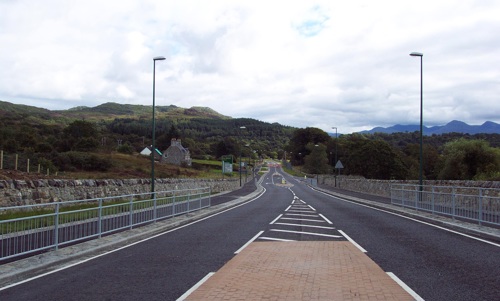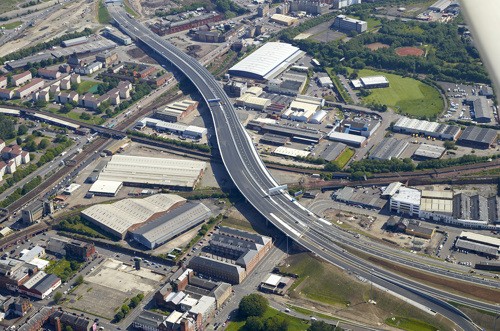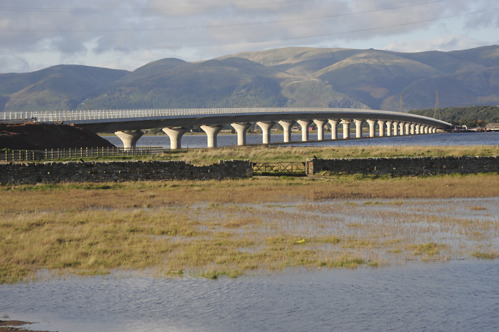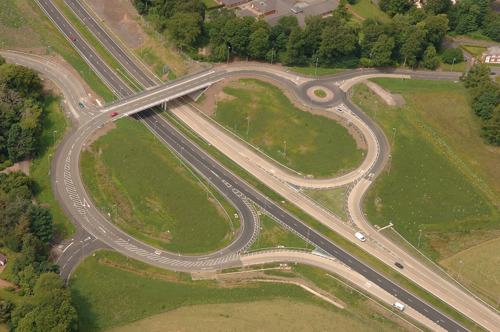West footpath/cycleway is currently closed for essential maintenance, please use the east footpath/cycleway.
Open to all permitted vehicles
Access RestrictionsIain Murray
Operations Director for Employer's Delivery TeamThere’s no more ‘Scottish’ a profession than engineering. Scots-born pioneers like James Watt, Thomas Telford and William Arroll helped shape the modern world – inspired, no doubt, by the challenges presented by the geography of their small but dramatically-formed homeland.

Homegrown engineer, world-class projects
So it’s fitting that the Forth Replacement Crossing (FRC) project employs lots of contemporary Scots engineers, many of whom have already crossed paths in the past, in different roles, on different projects and for different employers. Ironically, the world of major infrastructure, many hundreds of thousands of tonnes of concrete and steel, is also a pretty small one.
One such home-grown engineer is Iain Murray, Operations Director for the FRC Employer’s Delivery Team, working for global technical, professional and construction services provider Jacobs. Iain has had a hand in many of the biggest road projects in Scotland over the past 30 years or so. Previously, he headed the design consultancy on the high profile M74 Completion in Glasgow. Further back, the CV includes the Clackmannanshire Bridge over the Forth, extending the M77, upgrades of the M74 towards the English border and so on. In fact, he would be hard pressed to travel any reasonable distance in Scotland by car and not find himself in professionally familiar territory.
“I remember years ago when I was in the car with an early mentor of mine, Donald Forrest, and seemingly everywhere we drove there would be some part of the network Donald had a hand in. As I think about it now, I’m in the same situation. If I cross the border and head north into Scotland on the M6 and M74, these roads are all upgrades I worked on. The further north you go, east, west or central, you don’t get too far without finding a part of the network I’ve been involved with.”

Iain Murray - On site at the Queensferry Crossing
Born in Glasgow and raised in Dumfries and Galloway (the land of road and bridge pioneer Thomas Telford), Iain is the son of an electrical engineer and so a technical profession always seemed on the cards.
“Growing up in Kirkcudbright, you’re a long way from higher education and further learning institutions. So my school, Kirkcudbright Academy, organised trips to various colleges and universities to let us get a feel for things. I was looking at various departments at Glasgow University and by chance a trip around the civil engineering department was just starting. So I joined it and I really liked what I saw.
“I had always been aware of electrical engineering through my dad. He was based at the Tongland Power Station, which was one of the five dams that flow down the River Dee as part of the hydro-electric power network in Galloway. Looking back, I guess that’s where the interest in big structures and engineering comes from too.”
He applied to take civil engineering at Paisley College of Technology (now the University of West of Scotland) – a renowned school of engineering that, at the time, did a sandwich degree offering practical experience for six months in second and third year. “That really appealed to me and as part of that I worked with Babtie Shaw and Morton (later acquired by Jacobs) on the A75 Gatehouse bypass, my first experience working for a Government client.”

A830 Arisaig Village
“Back then, public sector contracts were based on the ICE 5th Edition where the consultant designed and tendered the scheme and then supervised the works. As a student you got involved in everything including checking the setting-out of the fence lines, batter rails for earthworks, drainage runs, pavement construction and measurement of quantities for checking the monthly invoice from the contractor.
“Once I started getting that experience, I was committed. This was what I wanted to do. At college, there’s always a lot of casualties along the way; around 80 people started the course and by the time you get to the final year there’s only 30 to 40 left. Following my two six month stints on the Gatehouse Bypass I was offered a permanent job as a graduate under agreement, which helped me decide this was the career for me. I really was thoroughly enjoying what I was doing.”
Babtie Shaw and Morton, based in the grand art deco Scottish Legal Life Building on Bothwell Street in Glasgow, were one of the biggest names in Scottish consultancy. They were bought by Jacobs in 2004 and the local Scots expertise and experience was retained, including Iain and many Jacobs’ staff now working on the FRC.
Iain says: “Babtie was a big company from a Scottish perspective. Over the period I was with them, it grew significantly through purchasing companies and we bought in to a lot of the road maintenance companies that were starting to appear to look after English council road networks.”
Road building in Scotland is a relatively mature industry, responsibility for new roads was in effect devolved to the Scottish Office and local authorities many decades before the Scottish Parliament opened in 1999. For that reason, generations of experience has been available to new recruits to tap into.
“Not long after I started,” recalls Iain, “I was working on the Dunblane bypass under Donald, who was a real traditional project engineer. “Guys like him knew everything. Literally, their designs were so good and thorough there were hardly any challenges left when you got on to site.
“He was a great guy to learn from, a great mentor. He had the kind of reputation that people could literally tell it was a ‘Donald Forrest job’. No stone was left unturned.”
In 1986, the Dunblane bypass on the A9 gave Iain the experience he needed to sit his ‘civils’, including designing the Showfield underpass.
The following year, his first experience actually based on site was on the dualling of the A90 near Stonehaven. On this project, he also ran into Morrison Construction, still a relatively small Highland-based operation at that time but who would go on to bigger things, including being a member of the current Forth Crossing Bridge Constructors (FCBC) consortium.
Iain then progressed to a senior project manager role as part of completing the motorway gap between the M6 near Carlisle and the M74 at Abington. He worked on the Gretna to Kirkpatrick Fleming section. “That was great experience to get so early, a big motorway job of around 10km or so.

Port Eglinton Viaduct
In 1994, he was seconded to the then Scottish Office roads department, getting his first taste of working directly with the civil service. Working in New St Andrews House and then the new Victoria Quay building in Leith, Iain looked after various schemes on the A90 between Perth and Dundee. The experience would prove formative.
“A key thing for me when working with a government client is the experience I’ve gained and the understanding of what the client’s demands are. Working as a client is different. In a design office, you have a big team around you, when you work in a client organisation often you’ve got to be more self-reliant and learn how things are done. It’s given me a good insight into how to deal with the government environment.”
Prior to the end of his secondment in 1995, Iain helped co-ordinate the contract documents for the major M6 DBFO scheme – one of the biggest road contracts Scotland had then seen. It wasn’t long before he returned to the same scheme, this time as a project manager tendering for and co-ordinating the design on site for the Beattock to Cleuchbrae and Carlisle to Guards Mill sections of the first ‘design, build, finance,operate’ (DBFO) project on Scotland’s roads.
Other notable projects on his CV include the A830 Arisaig to Kinsadel.
“That was interesting because we were out in a remote area, so it really needed to be a very self-sufficient project. A lot of materials were used or re-used by the contractor in a really efficient, innovative way. A lot of rock cutting was generated into aggregate. It was a great job, borne of necessity, that ended up looking great too.”
Another major project Iain was involved at a senior level in was the M74 Completion, the long-awaited extension to the motorway through (and over) the south side of Glasgow that opened in 2011.
“It was a really pleasing project. I was the project director for the Jacobs Atkins design joint venture. It was designed well, delivered on time and the contractor built the job well. It was a really good job considering how difficult the land was to work with. There was a lot of contamination from Glasgow’s industrial past that required a major clean-up operation.
“I live in the west and I know people really appreciate the benefits that that road brings.”
The role of the consultant in major infrastructure project can vary but often it provides the glue that binds the wider project team together. Iain’s experience, working as client, designer and contractor, instills an empathy for the nuanced objectives and pressures that parties face on a major project.
“I recall we made big changes in the M6 DBFO, republished three Environmental Statements and modified the Road Orders. It was an unusual amount of changes to a scheme and it was high pressure stuff for me to try and get the design delivered so they could start construction. Ultimately, I was the sponge protecting the designers, taking it all from the contractor.
“I’d like to think over the time I’ve been with Jacobs, and my responsibility for business with Transport Scotland and its predecessors, we always do a good job. I think we’ve built our reputation on quality service. Clients such as Transport Scotland have a lot of challenges. They have a lot of commitments to Ministers, it’s important for them the consultant understands that.”
Due to the sheer scale, the FRC is a very different project in a lot of ways to anything seen in Scotland for a generation. However, it is also one that brings every aspect of Iain’s career to date into play.
“When I was on the Upper Forth Crossing (the new bridge at Kincardine which opened in 2009), I was the Engineer responsible for the day-to-day running of the project, Transport Scotland was not based on site, although the project manager would be there fairly regularly. But on the FRC the client is part of the combined Employer’s Delivery Team (EDT) with the Jacobs Arup joint venture. I can honestly say for the duration of this job I’ve felt EDT first and foremost. I think we all operate as that rather than individual companies or departments. We’re a well-oiled team bringing together an amalgam of all of these experiences, a real mixture of skills.”

Clackmannanshire Bridge
The FRC won’t just deliver the Queensferry Crossing bridge. It also involves the upgrading or creation of around 12 miles of the road network. So it’s no surprise that it represents something of a meeting place for many Scots engineers whose careers have been leading to the biggest infrastructure project Scotland has seen for many years.
“I have worked with many of the guys here on various projects over the years. I’ve worked on the M6 DBFO, M77 Glasgow Southern Orbital (GSO), M74 Completion and even though different contractors might win the projects, you tend to see the same faces.
“At the same time, the challenges we’ve had were getting the right people for the jobs and we’ve been very good at doing that. One of the key things is we bring experience at both Jacobs and Arup , together we have people who have done this before and have done it on both sides of the contract.
“So we understand the challenges the contractor has. Sometimes, frankly, it can be difficult to stay on the right side of the line because ultimately the responsibility to deliver this job is with the contractor. So our role is to influence and assist as best as we can, allowing them to benefit from our experience and pick up things that they can use.”
The FRC has also demanded innovation in the types of roles required. The Employer team now has a dedicated programme, with quality and communications managers based on site. When projects get to construction, this expertise can traditionally slip down the priority list, but they’ve not been allowed to do so here.

M70 GSO interchange
“Another difference with other employer teams is having a full time health and safety manager which we’ve never had before on the client side of things. That’s been very good and allowed us to focus on making absolutely sure that the big team here has the proper training. Having someone full time to assess the training and equipment required and having an experienced health and safety professional for the contractor to call on has been invaluable.
“At the end of the day, the job will only be a success if we do it without anybody getting hurt. That will be the measure of success. We know how iconic the other Forth bridges are but we also know, unfortunately, there were fatalities during their construction. Our mission is to build this project safely, so everyone goes home at night.”
Iain is also very aware of the huge benefit this project is providing the current and next generation of Scottish engineers.
“We’ve had three major construction contracts on this project – four when you count the building of the Contact and Education Centre - and this has given us a great opportunity to have a lot of new talent here. They’ve all appreciated the opportunity of getting experience on a project like this. To sit their exams to become Chartered Engineers with a project like this on their CVs and the experience they have gained, you’re simply not going to get that anywhere else. It will stand them in great stead, the examiners will be so keen to talk about this project first and foremost with them.”
Of course, for any engineer the chance to work on the third of a triumvirate of world-class bridges on the Forth is special, for a Scottish engineer it’s something else again. Although Iain has a slightly different take:
“First of all, I’ve already crossed the Forth at Kincardine! That was a great project to be involved in and I thoroughly enjoyed it. I’m now crossing it again.
“To have been the Engineer on the Upper Forth Crossing and now member of the senior team building the Queensferry Crossing is really significant for me. Two of the major bridge crossings in Scotland – one, of course, the biggest - I’m very lucky to have the opportunity to work on both of them. A few of my colleagues here can lay that claim – not many can - and for us all, that’s got to make you feel very lucky.
“The bridge we’re looking at here, it will be remembered forever and the people involved will be talked about for a long time to come. It’s nice to be a part of that.”


